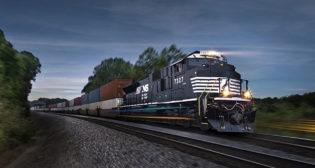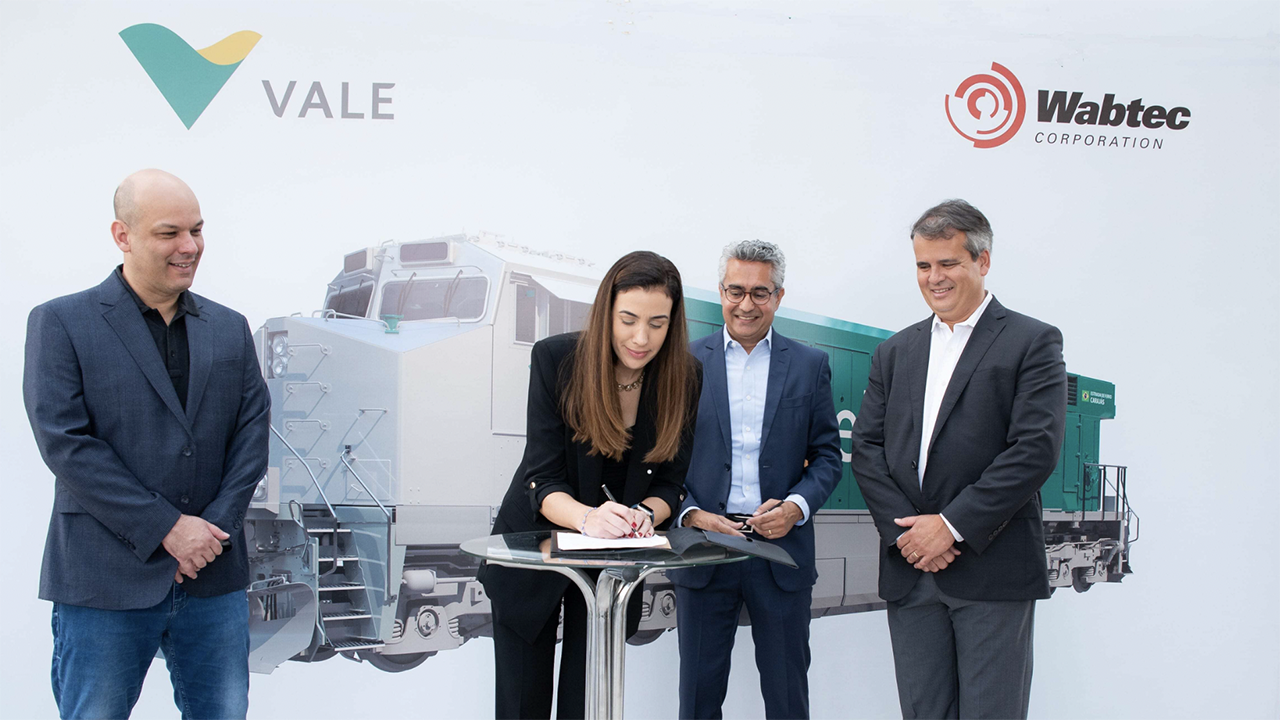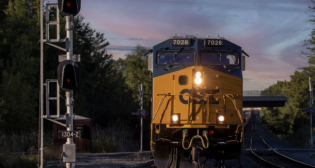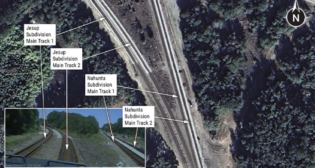
Wabtec Lands FLXdrive Order, Alternative Fuel Testing Partnership With Vale
Written by Marybeth Luczak, Executive Editor
Ludmila Nascimento, Energy Director, Vale, signs agreement beside Marco Braga, Global Procurement Director, Vale (at left); Danilo Miyasato, President of Wabtec for Latin America; and Rogério Mendonça, President Freight Equipment Global, Wabtec (Caption Courtesy of Vale. Photo Credit: Fernanda Divardim)
Wabtec Corporation is supplying three FLXdrive battery locomotives to global mining company Vale, and the two companies are teaming to test ammonia as an alternative fuel replacing diesel, they reported July 13.
The three 100% battery-powered FLXdrives will be used on Vale’s Carajás Railroad (EFC) in Brazil, which the companies said runs one of the world’s largest iron ore trains, comprising three to four diesel locomotives and 330 railcars transporting 45,000 tons. When delivered in 2026, the new units will join the diesel locomotives “to form Brazil’s first hybrid consist pulling the train uphill for 140 kilometers [87 miles] in Açailândia, in the state of Maranhão, where fuel consumption is the highest,” according to Vale and Wabtec. The FLXdrives will replace the two supplementary diesel locomotives (“dynamic helpers”) that the companies said are now used to help pull the train uphill.
The FLXdrives—to be built at Wabtec’s Contagem plant in the Brazilian state of Minas Gerais—feature an energy management system that recharges the batteries along the route as the train brakes. “It’s what we call regenerative energy produced by dynamic braking,” explained Alexandre Silva, Manager of Vale’s Powershift Program, which is studying alternative technologies to replace fossil fuels with “clean” sources in the company’s operations. “Today, that energy is lost when a traditional locomotive brakes. In the downhill sections, we will be able to recharge the batteries, without having to stop the train’s operation.”
According to the companies, the FLXdrives are estimated to save 6.6 million gallons (25 million liters) of diesel per year, considering the consumption of all EFC’s trains that use the dynamic helper.* This savings, they pointed out, would reduce carbon emissions by approximately 63,000 tons, the equivalent emissions of around 14,000 passenger cars per year.**

Vale and Wabtec will also work together on a two-year study to use ammonia as a clean alternative fuel, which they said does not emit CO2. The study will initially be carried out as lab tests to validate performance, emission reductions and feasibility.
According to Wabtec, among the advantages of ammonia are:
- Allowing the locomotive a longer range than other carbon-free fuels.
- Having a high-octane rating and an established large-scale distribution infrastructure.
“Initially, we are maximizing energy efficiency, replacing the diesel locomotives in the dynamic helper with battery ones [FLXdrives], but the idea is that, in the future, the other locomotives on the train can be fueled by ammonia,” Vale Director of Energy Ludmila Nascimento said. “This way, we would have a clean operation at EFC. This agreement is the first of many that we are seeking in order to accelerate the decarbonization of our railway operation.”
“Vale’s innovative approach to adopting alternative fuels for its locomotives will benefit its customers, shareholders and communities,” said Danilo Miyasato, President and General Manager of Wabtec for Latin America. “The FLXdrive provides Vale productivity, safety, fuel economy and emission reductions for its rail network.”
Vale, headquartered in Brazil, produces iron ore, nickel and copper. Its operations include approximately 1,243 miles (2,000 kilometers) of railways, marine terminals and 10 ports around the globe. In 2020, it announced an investment of between $4 billion and $6 billion to reduce its direct and indirect emissions (scopes 1 and 2) by 33% by 2030. According to Vale, its rail network represents 10% of its carbon emissions. This new initiative is one more step toward achieving the goal of zero emissions net carbon emissions by 2050, in line with the ambition of the Paris Agreement to limit global warming to below 2°C by the end of the century, reported Vale, which noted that it is also committed to reducing its net emissions from its value chain (scope 3) by 15% by 2035.
* The use of Diesel-B15 [15% biodiesel] in Brazil as of 2026 was considered for the calculation.
** The comparison was made from the U.S. Environmental Protection Agency’s greenhouse gas equivalence calculator.

Wabtec’s Alternative Fuel Technology Initiatives
Wabtec currently has more than 40 locomotives operating with various blends of fuels, for example, 20% biodiesel and 80% renewable diesel, according to Railway Age Editor-in-Chief William C. Vantuono’s Next-Gen Motive Power report, published earlier this year. What’s the difference between biodiesel and renewable diesel? “Biodiesel is close to diesel, but with more waxes and paraffins and other elements,” Wabtec Executive Vice President and Chief Technology Officer Eric Gebhardt told Vantuono. “It’s chemically different. Renewable diesel is hydrogenated, so it’s a pure form of the diesel molecule. In fact, it’s actually a little too pure, so it requires additives to improve viscosity. We’ve approved up to 5% biodiesel and up to 30% renewable diesel for our locomotives, and we’re trying to get to 20% biodiesel and up to 100% renewable diesel. Both types come from the same feedstocks.”
Vantuono reported that “FAME (Fatty Acid Methyl Ester) is the generic chemical term for biodiesel derived from renewable sources. It is used to extend or replace mineral diesel and gas oil used to fuel on- and off-road vehicles and static engines. FAME consists of acids created during the transesterification of vegetable oils and animal fats to create biodiesel. These high molecular weight oils and fats react with short chain alcohol in the presence of a catalyst, usually potassium hydroxide, to produce lower molecular weight esters.”
Gebhardt told Vantuono: “We need to understand what engine parts would have to be changed out burning these different types of fuels—things like hoses and seals. We want to understand the deterioration factors, the impact on fuel injection systems, for example, to stay within current emissions compliance standards. Fuel injectors have very precise passages. We need to make sure we can reach the NOx and particulate matter requirements. We’re working with our customers through field tests, inspecting these units to make sure we know what the maintenance intervals need to be. We’re less concerned about the metals (internals). We don’t think any of those would be a large concern, with the right lubricity (the measure of friction reduction) and viscosity (the measure of a fluid’s resistance to flow) additives. We’re paying close attention to how elastomers and hoses, the rubber components, will interact. We have a program with the Class I’s, and we don’t see any reasons why we won’t be successful with this. Longer term, it’s going to be important for our customers to understand the availability and cost of these fuels. Some parts of the U.S. have significant subsidies—California, for example. The price points might vary in different parts of the U.S.”
According to Vantuono’s report, Wabtec’s FLXdrive program “is progressing to the next level. The 2.4 MWH ‘version 1.0’ successfully tested with BNSF between Barstow to Stockton, Calif., registering an 11% fuel savings operating in a consist with two diesel-electrics, vs. a three-unit diesel-electric. “We now have two new iterations,” Gebhardt said. “The first is what we call the FLXdrive 2.0, with 7 MWh, the first two of which are shipping at the end of this year to Australia for a trial with BHP Western Australia Iron Ore (in the same trial as Progress Rail’s SD70J-BB).”
This will be followed by the FLXdrive 2.5, which replaces the NMC (nickel-manganese-cobalt) batteries with GM’s Ultium NCMA (nickel-cobalt-manganese-aluminum) technology manufactured by Ultium Cells LLC, a joint venture of GM and LG Energy Solution, according to Vantuono’s report. “We’re utilizing the Ultium designed for the Hummer truck,” Gebhardt told him. “We’ll ruggedize it. The batteries have individual cells; a module consists of a stack of cells. Several modules create a pack. One weighs more than a ton, but they have a lot of energy capacity. We’ll take the Hummer pack and stack 42 inside the locomotive, and that gets us to 8-plus MWh.”
“It’s not how much power you have when you start or end the route,” Gebhardt said. “It’s the fact that you’re regenerating the electricity. There are parts of the route that have high standard deviation, in terms of grade. You can generate a lot of energy with a train that might have 10,000, 20,000 or 30,000 trailing tons. If you think about the 2.4 MWh hour version that one saves about 11%, with an 8 MWh unit we could save 20% or 30% on fuel usage, depending on track standard deviation.”

Wabtec’s venture into hydrogen includes HFC as well as burning hydrogen inside an internal combustion engine, according to Vantuono’s report. “The company is working with GM to utilize its Hydrotec fuel cell technology in a hybrid unit, with batteries supplying traction power,” he wrote. “The fuel cells would be trickle charging the batteries.”
“The game-changing part of fuel cells is efficiency,” Gebhardt told Vantuono. “We’ll be working toward 65% efficiency, compared to 40%-42% with an internal combustion engine. Fuel cells have that significant advantage, which should be achievable over the next decade or so. We have to make sure that we understand how to provide enough fuel for those fuel cells. Right now, the energy density, volumetric energy, of hydrogen is low. If we’re going to offer a main line solution, it will have a tender car. Our locomotives carry about 5,000 gallons of diesel. One kilogram of hydrogen is equivalent to one gallon of diesel, roughly, in energy content (expressed as DGE, diesel gallon-equivalent). To get that same amount would require a tender car with about 7,000 kilograms of hydrogen. That amount provides more range than 5,000 gallons of diesel. Because of the volume, we’ll need a tender. But we are operating with LNG tenders in Florida and Mexico, so we understand how to work with them, and with liquid and gaseous fuels.”
Vantuono reported that burning hydrogen in an internal combustion engine will be similar to LNG. “We’re working with Argon and Oak Ridge National Labs on this as part of a Department of Energy grant,” Gebhardt told him. “We’re looking at different configurations to see how much of a blend of hydrogen with diesel for energy content we can get to. Our goal is to get into the 90%-plus range, to stay with compression ignition, avoiding spark plugs. Part of that has to do with what our customers are looking for. Spark ignition has shorter maintenance intervals. Compression ignition is more robust, with longer maintenance intervals. Spark ignition with hydrogen or LNG is maybe an easier solution, but it does require more maintenance.”
Further Reading:
Zero/Low-Emission Locomotive Global Roundup
Renewable Fuels Testing Under Way at UP
BNSF, Wabtec to Test Higher-Percentage Blends of Biofuels
UP Acquiring 20 Battery-Electrics for Yard Service
First Look: Wabtec ES44ACi Diesel-Electric for Brazil
BNSF/Wabtec BEL Pilot: The Results Are In



